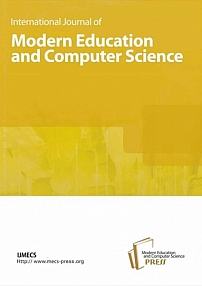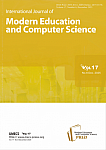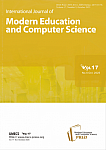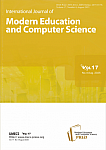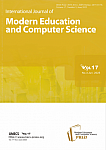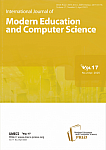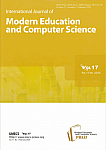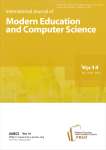International Journal of Modern Education and Computer Science @ijmecs
International Journal of Modern Education and Computer Science
IJMECS has been abstracted or indexed by several world class databases: Scopus, Google Scholar, Microsoft Academic Search, CrossRef, Baidu Wenku, IndexCopernicus, IET Inspec, EBSCO, JournalSeek, ULRICH's Periodicals Directory, WordCat, Scirus, Academic Journals Database, Stanford University Libraries, Cornell University Library, UniSA Library, CNKI Scholar, ProQuest, J-Gate, ZDB, BASE, OhioLINK, iThenticate, Open Access Articles, Open Science Directory, National Science Library of Chinese Academy of Sciences, The HKU Scholars Hub, etc..
IJMECS is committed to bridge the theory and practice of modern education and computer science. From innovative ideas to specific algorithms and full system implementations, IJMECS publishes original, peer-reviewed, and high quality articles in the areas of modern education and computer science. IJMECS is a well-indexed scholarly journal and is indispensable reading and references for people working at the cutting edge of computer science, modern education and applications.
The journal publishes original papers in the field of Modern Education and Computer Science which covers, but not limited to the following scope:
Computer Education
Computer Aided Instruction
Network University
Network Curriculum
Computer Network Education
Computer Distance Learning
Countryside Distance Learning
Education Information Technology
Educational Technique standard
Computation Thought and Computer Method Study
School Teachers Educational Technique Ability Training
The Teaching Resources' Design, Develops and Applies
Modern Distance Learning Resources Effective Applied Research
College Network Education Innovation Research
Educational Technique's Application in the Vocational-Technical Education
Teacher Educational Technique Training Studies with the Teacher Career Development
Digit Sports Research
New Technology in Teaching Domain Application
Under the Informationization Environment New Study and Teaches to Study
Classroom Instruction Research
Foreign Language Teaching Research
Mathematics Education Research
Physics Teaching Research
Chemistry Teaching Research
Management Science Teaching Research
Lifelong Education Research
Special Crowd Computer Education
E-service
Information Security
Information Hiding and Digital Watermark
Multimedia Technology
Database Technology
Artificial Intelligent System
Pattern Recognition
Data Mining and Knowledge Discovery
Pattern recognition
Software Engineering
Control Technology
Network Engineering
Communication
Graph and Image Processing
Computer Application Technology
Modern Education & Computer Science Press
Выпуски журнала
Статьи журнала

The Technique of Key Text Characteristics Analysis for Mass Media Text Nature Assessment
Статья научная
The paper presents the technique for analysis of text emotional nature which is a key characteristic of Mass media news text. Emotions inherent design its Emotional coloring and become a significant feature of mass media news texts. The technique proposed measures the degree of exposure of emotions and allocates them by rating. Emotional coloring is defined by emotional characteristics and by grammar categories, and a set of rules is applied to regulate wordforms interaction. Techniques for verbal units analysis are examined. The Heavy Natural Language Processing models and Machine learning techniques are considered. They are compared and the optimum one is defined to resolve the problem of Emotional coloring evaluation. A system prototype is developed on the basis of this technique. It allocates news by influence rating according to their key parameters. The examples of texts’ emotional nature recognition results by means of the prototype are presented. The visualization of emotional nature analysis results highlights additional features of the news text’s emotional nature and expresses them in numeric values. It is exposed both by sentences and by the whole news text, with tracking of news Emotional coloring dynamics. The results presented have application in analysis procedure intending to studying Mass media, particularly informational environment with concomitant factors, and their impact on political and social interrelation.
Бесплатно
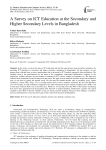
A Survey on ICT Education at the Secondary and Higher Secondary Levels in Bangladesh
Статья научная
In this study, we show the status of ICT education and find the gaps between rural and urban institutions for providing ICT education in secondary and higher secondary institutions in Bangladesh. For this purpose, we use primary data collected using a survey questionnaire that is answered by ICT teachers engaged in those institutions. The variables used in the questionnaire are the name of the respondents, educational qualification, locations of the institutions, syllabus structure, the total number of students for ICT courses, number of computers, etc. The data were collected from institutions located in urban and rural areas. We apply several statistical functions along with conditional logic to our data for getting the desired result. We find that the students-teacher ratio in secondary (resp., higher secondary) is about 288:1 (resp., 212:1), existing teachers have a heavy academic workload. We also find that there exist low facilities in rural institutions compared to the urban institutions because students-computer ratio (SCR) is 46 in rural areas whereas SCR is 22 in the urban area. Moreover, we find that more than 80% of the teachers conducting ICT classes have graduated from the discipline other than ICT or related discipline. Furthermore, teachers who cannot complete at least 80% of the ICT syllabus in time are mostly non-ICT graduate. Based on these findings, we propose some recommendations to meet the above gaps of the current ICT education in Bangladesh.
Бесплатно
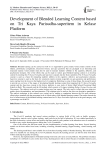
Development of Blended Learning Content based on Tri Kaya Parisudha-superitem in Kelase Platform
Статья научная
Blended learning can be carried out well if it is supported by good content. Good content consists of the subject, performance assignments, discussion forums, and quiz questions that are packaged in an interesting and structured manner. Good content must also be used to measure students’ abilities in the cognitive, affective, and psychomotor domains. One of the efforts that can be made to realize good blended learning content is to develop content by inserting the Tri Kaya Parisudha and Superitem concepts into the Kelase platform. The Tri Kaya Parisudha concept is used as a basis for measuring students’ abilities in the cognitive, affective, and psychomotor domains. Superitem concept is used as the basis for structured content creation (especially on quiz questions and performance tasks) starting from the lowest to the highest level of complexity. Referring to some of those things, this research aimed to provide an overview of the stages of developing blended learning content that integrated the Tri Kaya Parisudha concept and the Superitem concept in the Kelase platform (a case study of Senior High Schools/Vocational High Schools in Bali). This research used the 4D method, which consists of 4 stages, including Define, Design, Develop, and Disseminate. The subjects involved in content testing were four experts. The tools used to collect data were interview guides, photo documentation, and questionnaires. The technique used to analyze the data was descriptive quantitative. The analysis technique in this research was carried out by making a comparison between the five-scale reference effectiveness standard with the percentage level of effectiveness of the blended learning content. The results showed the level of effectiveness of the blended learning content based on Tri Kaya Parisudha-Superitem in the good category with a percentage was 88.667%.
Бесплатно
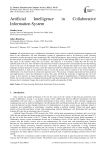
Visual Block-based Programming for ICT Training of Prospective Teachers in Morocco
Статья научная
We conducted a training experimentation on computer coding whose aim is to probe ICT skills enhancement of pre-service teachers in Morocco. For that, we have developed and implemented training sessions using a visual programming tool (Scratch) targeting 63 prospective teachers at the Faculty of Educational Sciences (FSE) and the Regional Center for Education and Training Professions (CRMEF) in Nador, Morocco. During these sessions, trainees were introduced to algorithmic thinking where they implemented teaching sequences in their specialty subjects using Scratch. Pre and post surveys were conducted to measure the evolution of the trainees’ perceptions towards the integration of computer coding in the teaching and learning of their specialties. The analysis of the surveys showed the potential of integrating computer coding in the development of learners’ transversal skills. The training revealed different possibilities of exploiting visual block-based programming environments in the teaching and learning process.
Бесплатно
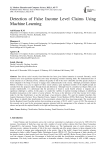
Detection of False Income Level Claims Using Machine Learning
Статья научная
Data driven social security fraud detection has been given limited attention in research. Recently, social schemes have seen significant expansion across many developing countries including India. The fundamental aims of social schemes are to alleviate poverty, enhance the quality of life of the most vulnerable and offer greater chances to those relegated to the fringe of society to engage more enthusiastically in the society. Although governments channel billions of dollars every year in support of these social schemes, quite significant number of the eligible people are excluded from the program mainly through fraud and dishonesty. Although fraud is considered an illegal offence and morally reprehensible, it is unfortunate that the prevalence of fraud in social benefit schemes is rampant and a significant challenge to address. In this paper, we studied the viability of machine learning techniques in identifying fraudulent transactions in the context of social schemes. We focus on the detection of the false income level claims made by the fake beneficiaries to get the privileges of government scheme. We used the standard classifiers like Logistic Regression, Decision Trees, Random Forests, Support Vector Machine (SVM), Multi-Layer Perceptron and Naïve Bayes to identify fake beneficiaries of the government scheme from those deserving people. The results show that the Random Forest Classifier perform best providing an accuracy of 99.3% with F1 score of 0.99. The outcome of this research can be used by the government agencies entrusted with the management of the schemes to wade out the abusers and provide the required benefits to the right and deserving recipients.
Бесплатно

